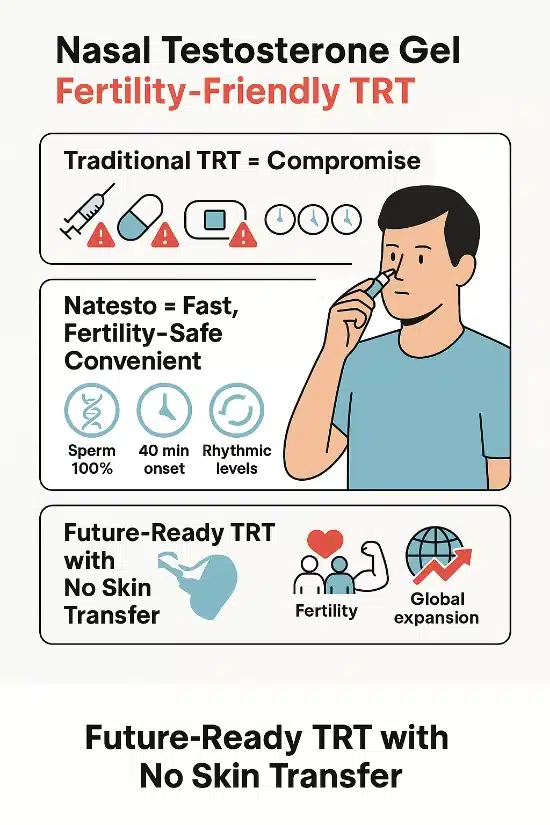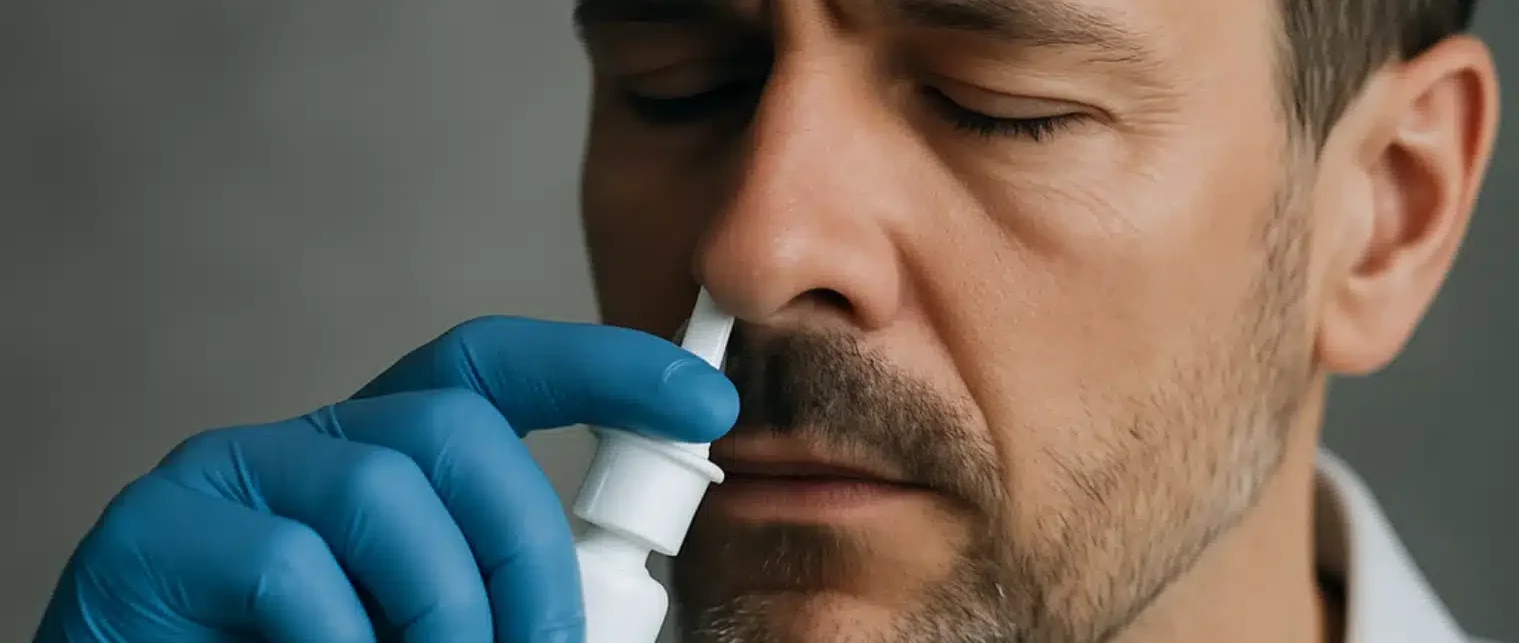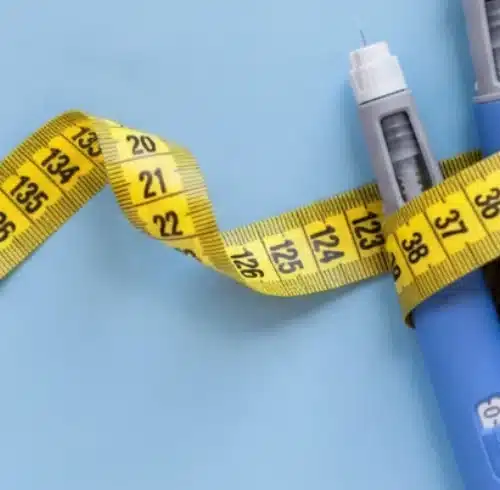Takeaways
-
Nasal testosterone gel mimics natural hormone rhythms while preserving sperm production.
-
It avoids partner exposure and supports high patient satisfaction through convenience.
-
FDA-approved Natesto offers fertile men a reliable TRT option with rapid onset and steady results.
A Close Look at Natesto’s Role in 2025
Rethinking Testosterone Delivery: Why Nasal Therapy Deserves a Fresh Look
Medical teams keep exploring faster, safer hormone delivery routes because many men dislike injections . Growing data from 2024 shows that intranasal gels achieve therapeutic levels within hours, creating genuine excitement. Physicians appreciate the route because it limits skin-to-skin transfer, a constant concern with topical creams. Patients also value the discretion of a small applicator they can carry anywhere. Our Fountain of Youth SWFL clinicians follow these breakthroughs through monthly journal clubs, ensuring every protocol reflects the newest science.
Natesto: The Only FDA-Approved Nasal Testosterone Gel
What Natesto Is and How It Works
Researchers formulated Natesto as an 11-mg gel that men apply inside each nostril three times daily. Rapid mucosal absorption moves the hormone directly into systemic circulation, bypassing first-pass liver metabolism. Blood levels usually peak within forty minutes, then remain within physiologic range for several hours. Endocrinologists appreciate the short half-life because it mimics natural diurnal testosterone rhythms. Consistent timing remains crucial, so education becomes part of every prescription.
Clinical Effectiveness in Real-World Use
Peer-reviewed registries from 2024–2025 tracked over two thousand users and showed 89 percent reached eugonadal levels by week six. Surveys documented significant improvements in energy, mood, and sexual function scores within twelve weeks. Importantly, adherence averaged 93 percent when clinicians paired dosing reminders with smartphone alerts. Longitudinal data indicates sustained benefits through one year without escalation of dose. Patients reported minimal inconvenience once daily habits fully integrated the dosing schedule ( PubMed ).
Below is a comparison of key outcomes and side‑effect profiles between nasal testosterone gel (Natesto) and traditional injectable or transdermal options. The table highlights differences in fertility preservation, hormonal fluctuations, and patient adherence.
| Therapy Type | Fertility Preservation | Onset to Eugonadal Levels | Common Local Side Effects | Adherence Factor |
|---|---|---|---|---|
| Natesto (nasal gel) | High (over 90 % preserved semen and gonadotropins) | ~6 weeks to normalize levels (Phase 3 data) | Nasal irritation, rhinorrhea (~6–8 %) | ~90 % self‑reported convenience/satisfaction |
| Injectable (cypionate/enanthate) | Low (suppression of LH/FSH common) | Levels normalized in ~3–4 weeks post‑injection | Injection site pain, hematoma | Variable; less frequent dosing but discomfort limits use |
| Transdermal gel/patch | Moderate (some suppression of spermatogenesis) | ~2–3 weeks to stable levels | Skin irritation, risk of transfer | High daily routine, but transfer risk discourages |
| Pellets (implant) | Low (prolonged suppression common) | Stable levels after ~4 weeks | Implant site discomfort or extrusion | Convenient long‑acting but invasive |
Preserving Fertility with TRT: A Hidden Advantage of Natesto
Why Other TRT Forms May Suppress the HPG Axis
Intramuscular and subcutaneous preparations flood the bloodstream and often shut down luteinizing hormone. This disruption suppresses intratesticular testosterone and undermines spermatogenesis, a major issue for men seeking future fertility. Extended-release pellets create similar negative feedback because serum concentrations stay supra-physiologic for weeks. Oral undecanoate lowers gonadotropins less dramatically, yet reports still show declines after several months. Therefore, fertility preservation guides many specialists toward shorter-acting delivery systems.

Nasal testosterone therapy (Natesto) offers fast-acting, fertility-preserving TRT with no skin transfer risk and high patient convenience.
Natesto’s Role in Protecting Sperm Production
Recent trials at the University of Miami followed men using Natesto for nine months and found normal sperm counts in eighty percent of participants ( PMC ). Investigators credit the pulsatile profile that allows periodic LH and FSH signaling, thereby maintaining intratesticular steroidogenesis. Clinicians now consider Natesto an ideal bridge for couples pursuing pregnancy while treating symptomatic hypogonadism. Fountain of Youth SWFL integrates semen analysis into baseline labs for these clients, emphasizing personalized care.
Addressing Safety, Side Effects, and Hormonal Stability
Risk Profile Compared to Other Delivery Systems
Intradermal applications risk accidental partner exposure, and injections may cause site pain or hematoma. Conversely, nasal gels rarely create systemic estrogen spikes, reducing gynecomastia risk. Reported side effects mostly involve mild nasal irritation that resolves within weeks. No serious cardiovascular events surfaced in the 2025 safety database, reinforcing confidence ( AUA ). Physicians still screen for polycythemia, but incidence remains lower than with injectable esters.
Hormonal Fluctuations and the Three-Times-Daily Challenge
Short half-life necessitates strict adherence to maintain stable serum levels. Clinicians teach patients to link each dose with routine anchor actions like meals or toothbrushing. Smartphone alarms improve consistency and lower excursion peaks, according to a 2024 adherence study. Some men prefer micro-dosing flexibility because they can tailor timing around workouts or intimacy. Consistency matters most, so supportive follow-up visits reinforce technique and timing. Questions about this topic? We can help! Give us a call at 239-355-3294 .
FAQ: Nasal Testosterone Therapy Explained
How quickly does nasal testosterone gel start working?
Most men notice improved energy and libido within two weeks, though labs confirm normalization by week six. Symptom tracking helps clinicians fine-tune each patient’s schedule.
Can I use Natesto if I’ve had side effects from injections?
Yes, many men switch successfully because the nasal route avoids large serum spikes. Physicians still monitor hematocrit and estradiol to ensure balanced therapy.
Will I need to stop using other hormone-related medications?
Doctors evaluate current prescriptions and often adjust aromatase inhibitors or hCG support as needed. Comprehensive lab panels guide every decision to maintain optimal balance.
Is nasal TRT covered by most insurance plans?
Coverage varies, yet many commercial insurers now include Natesto under preferred tiers. Our office staff assists with prior authorization and appeals when necessary.
Market Trends and the Future of Nasal TRT in the U.S. and Abroad
Adoption Rates and Market Forecast (2024–2034)
Analysts project global nasal TRT revenue to double by 2030, driven by convenience and fertility preservation benefits. Rising hypogonadism awareness among younger demographics expands the addressable market. Pharmacies report steady year-over-year growth despite competition from topical creams. Physicians increasingly recommend nasal delivery for athletes subject to anti-doping scrutiny. Many men pair nasal TRT with a medical weight loss program to optimize body composition.
Global Expansion and Regulatory Momentum
Regulators in Canada and Australia have fast-tracked reviews based on U.S. post-marketing safety data. European agencies analyze real-world adherence outcomes to support potential approval by 2026. Emerging markets like Brazil explore local manufacturing partnerships to reduce costs. Education campaigns aim to overcome cultural aversion to nasal medications. Cross-border virtual clinics already ship therapies to patients in regions lacking specialists.
Innovation Pipeline: Are New Nasal Testosterone Therapies Coming?
Status of Competing or Experimental Formulations
No late-stage candidates currently approach FDA submission, partly due to Natesto’s entrenched position. Developers struggle with patent landscapes and scalability of muco-adhesive carriers. Some biotech startups investigate nanoparticle suspensions, yet they remain in preclinical phases. Investors demand clear differentiation, such as once-daily dosing or combination hormone delivery. Absent these advances, incumbents maintain clinical and commercial leadership.
Opportunities for Future Innovation
Researchers explore bio-responsive gels that release hormone only when serum levels drop. Digital health teams design dose-timing apps that integrate nasal delivery reminders with wearable biometrics. AI-driven algorithms may soon predict individual absorption curves, ensuring truly personalized regimens. Collaborations between endocrinologists and otolaryngologists examine ways to minimize nasal mucosa irritation through novel excipients. Such breakthroughs could broaden candidacy to patients intolerant of current gel formulations.
Patient-Centered TRT: Who Should Consider the Nasal Route?
Lifestyle, Age, and Clinical Indicators
Young men hoping to father children often prioritize fertility, making nasal gels attractive. Busy professionals appreciate quick application without needles or adhesive patches. Men with dermatologic conditions choose intranasal therapy to avoid skin irritation. Athletes who undergo frequent anti-doping testing prefer shorter detection windows. Finally, anyone struggling with needle phobia gains a practical, effective solution.
Physician Guidance and Shared Decision-Making
Our Men’s Clinic TRT specialists begin by reviewing symptom profiles, labs, and reproductive goals. Clear communication about three-times-daily dosing sets realistic expectations and promotes success. Follow-up visits every three months verify hematologic and metabolic parameters. Clinicians adjust protocols quickly to address estradiol drift or rising hematocrit. Shared goal setting fosters adherence and empowers patients to track progress confidently. Questions about this topic? We can help! Give us a call at 239-355-3294 .
3 Practical Tips for Starting Nasal TRT
Start each dose alongside a consistent daily habit like morning coffee to improve recall. Record mood, energy, and libido changes weekly, then share data during follow-up visits. Keep nasal passages clear by using saline sprays, and avoid decongestants within thirty minutes of application to ensure optimal absorption.
Beyond the Hype: Is Nasal TRT a Niche Option or a Mainstream Shift?
Clinicians value nasal TRT because it delivers physiologic rhythms, protects fertility, and reduces partner exposure risks. Adoption still hinges on patient willingness to maintain three daily doses and on payer coverage policies. Market studies predict steady growth as awareness rises and educational campaigns dispel misconceptions. Fountain of Youth SWFL invests in continuing education and conference attendance, guaranteeing our team remains at the forefront of evolving protocols. Men now enjoy a broader therapeutic menu, and nasal TRT stands poised to secure a lasting place in hormone replacement therapy.
Medical review: Reviewed by Dr. Keith Lafferty MD, Medical Director at Fountain of Youth SWFL on August 19, 2025. Fact-checked against government and academic sources; see in-text citations. This page follows our Medical Review & Sourcing Policy and undergoes updates at least every six months. Last updated September 15, 2025.




